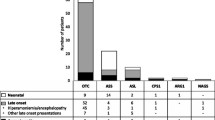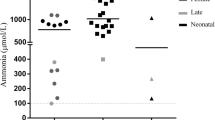Abstract
Urea cycle disorders (UCDs) are one of the most frequently inherited metabolic diseases in Japan, with an estimated prevalence of 1 per 50,000 live births. Here, we investigated the clinical manifestations, treatment, and prognosis of 177 patients with UCDs who were evaluated and treated from January 1999 to March 2009. These included 77 cases of neonatal-onset UCDs and 91 cases of late-onset UCDs. The most common UCD was ornithine transcarbamylase deficiency (OTCD), which accounted for 116 out of 177 patients. This result is similar to a previous study performed between 1978 and 1995 in Japan: OTCD accounted for about two-thirds of the total number of UCD cases. We studied the relationship between prognosis and the peak blood ammonia level at the onset in 151 UCD patients. Compared with a previous survey conducted in Japan, we found that a greater number of patients survived without any mental retardation despite their peak blood ammonia levels being greater than 360 μmol/l. The 5-year survival rate of patients with OTCD improved to 86% for those with the neonatal-onset type and to 92% for those with the late-onset type. We hypothesize that the increased survival rate is due to early diagnosis and better treatments that are now available in Japan. It is very important to diagnose and treat UCDs, especially OTCD, when the blood ammonia levels in patients are low. The outcome in patients with low blood ammonia levels was better than that in patients with high blood ammonia levels.



Similar content being viewed by others

References
Bachmann C (2003) Outcome and survival of 88 patients with urea cycle disorders: a retrospective evaluation. Eur J Pediatr 162:410–416
Bachmann C (2005) Long-term outcome of urea cycle disorders. Acta Gastroenterol Belg 68(4):466–468
Batshaw ML, MacArthur RB, Tuchman M (2001) Alternative pathway therapy for urea cycle disorders: twenty years later. J Pediatr 138(1 Suppl):S46–S54
Braissant O, Henry H, Villard AM et al (2002) Ammonium-induced impairment of axonal growth is prevented through glial creatine. J Neurosci 22:9810–9820
Brusilow SW (1991) Phenylacetylglutamine may replace urea as a vehicle for waste nitrogen excretion. Pediatr Res 29(2):147–150
Brusilow SW, Valle DL, Batshaw M (1979) New pathways of nitrogen excretion in inborn errors of urea synthesis. Lancet 2(8140):452–454
Feillet F, Leonard JV (1998) Alternative pathway therapy for urea cycle disorders. J Inher Metab Dis 21(Suppl 1):101–111
Kasahara M, Sakamoto S, Shigeta T et al (2010) Living-donor liver transplantation for carbamoyl phosphate synthetase 1 deficiency. Pediatr Transplant 14(8):1036–1040
Leonard JV (2001) The nutritional management of urea cycle disorders. J Pediatr 138(1 Suppl):S40–S44
Maestri N, Brusilow SW, Clissold DB, Bassett SS (1996) Long-term treatment of girls with ornithine transcarbamylase deficiency. N Engl J Med 335:855–859
Matsuda I, Tanase S (1997) The ornithine transcarbamylase (OTC) gene: mutations in 50 Japanese families with OTC deficiency. Am J Med Genet 71:378–383
Matsuda I, Nagata N, Matsuura T et al (1991) Retrospective survey of urea cycle disorders: part 1. Clinical and laboratory observations of thirty-two Japanese male patients with ornithine transcarbamylase deficiency. Am J Med Genet 38:85–89
Morioka D, Kasahara M, Takada Y et al (2005) Current role of liver transplantation for the treatment of urea cycle disorders: a review of the worldwide English literature and 13 cases at Kyoto University. Liver Transpl 11(11):1332–1342
Msall M, Batshaw ML, Suss R, Brusilow SW, Mellits DE (1984) Neurological outcome in children with inborn errors of urea synthesis. Outcome of urea-cycle enzymopathies. N Engl J Med 310:1500–1505
Nagasaka H, Yorifuji T, Murayama K et al (2006) Effects of arginine treatment on nutrition, growth and urea cycle function in seven Japanese boys with late-onset ornithine transcarbamylase deficiency. Eur J Pediatr 165(9):618–624
Nagata N, Matsuda I, Oyanagi K (1991a) Estimated frequency of urea cycle enzymopathies in Japan. Am J Med Genet 39:228–229
Nagata N, Matsuda I, Matsuura T et al (1991b) Retrospective survey of urea cycle disorders: part 2. Neurological outcome in forty-nine Japanese patients with urea cycle enzymopathies. Am J Med Genet 40:477–481
Nassogne MC, Héron B, Touati G, Rabier D, Saudubray JM (2005) Urea cycle defects: management and outcome. J Inherit Metab Dis 28(3):407–414
Nicolaides P, Liebsch D, Dale N, Leonard J, Surtees R (2002) Neurological outcome of patients with ornithine carbamoyltransferase deficiency. Arch Dis Child 86(1):54–56
Schaefer F, Straube E, Oh J, Mehls O, Mayatepek E (1999) Dialysis in neonates with inborn errors of metabolism. Nephrol Dial Transplant 14(4):910–918
Summar M (2001) Current strategies for the management of neonatal urea cycle disorders. J Pediatr 138(1 Suppl):S30–39
Uchino T, Endo F, Matsuda I (1998) Neurodevelopmental outcome of long-term therapy of urea cycle disorders in Japan. J Inher Metab Dis 21(Suppl 1):151–159
Uemoto S, Yabe S, Inomata Y et al (1997) Coexistence of a graft with the preserved native liver in auxiliary partial orthotopic liver transplantation from a living donor for ornithine transcarbamylase deficiency. Transplantation 63(7):1026–1028
Whitington PF, Alonso EM, Boyle JT et al (1998) Liver transplantation for the treatment of urea cycle disorders. J Inher Metab Dis 21(Suppl 1):112–118
Acknowledgments
This study was supported in part by a Grant-in-Aid for the Global COE Program from the Japanese Society for the Promotion of Science and Ministry of Education, Culture, Sports, Science and Technology; a Grant-in-Aid for Pediatric Research from the Ministry of Health, Labor and Welfare; and a Grant-in-Aid for Scientific Research from the Ministry of Education, Culture, Sports, Science and Technology.
We thank all 668 institutions and, in particular, the 87 institutions that kindly provided us with useful clinical information on patients with urea cycle disorders. We are very grateful to Mari Kimura and Asuka Sakamoto for their help in survey analysis. We express our gratitude to Professor Takahiko Katoh at the Department of Public Health, Kumamoto University for critical analysis of the statistical methods.
Author information
Authors and Affiliations
Corresponding author
Additional information
Communicated by: Claude Bachmann
Competing interest: None declared.
Electronic supplementary material
Below is the link to the electronic supplementary material.
ESM. 1
(PDF 61 kb)
Rights and permissions
About this article
Cite this article
Kido, J., Nakamura, K., Mitsubuchi, H. et al. Long-term outcome and intervention of urea cycle disorders in Japan. J Inherit Metab Dis 35, 777–785 (2012). https://doi.org/10.1007/s10545-011-9427-0
Received:
Revised:
Accepted:
Published:
Issue Date:
DOI: https://doi.org/10.1007/s10545-011-9427-0



